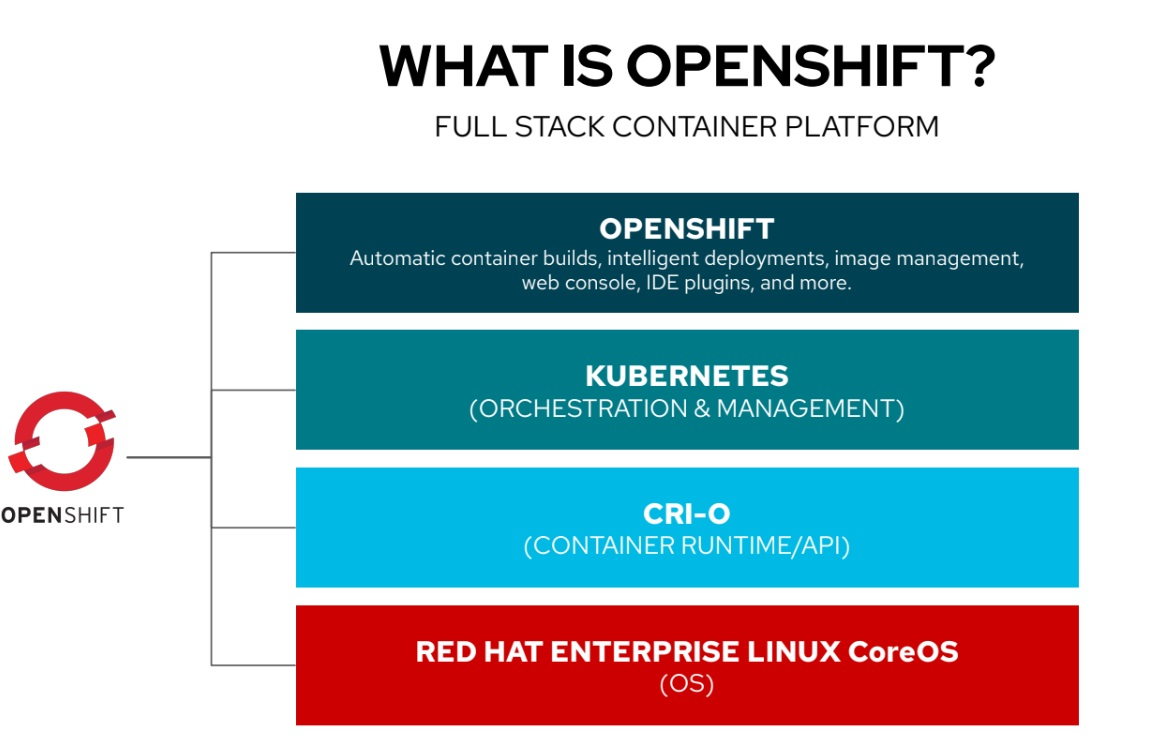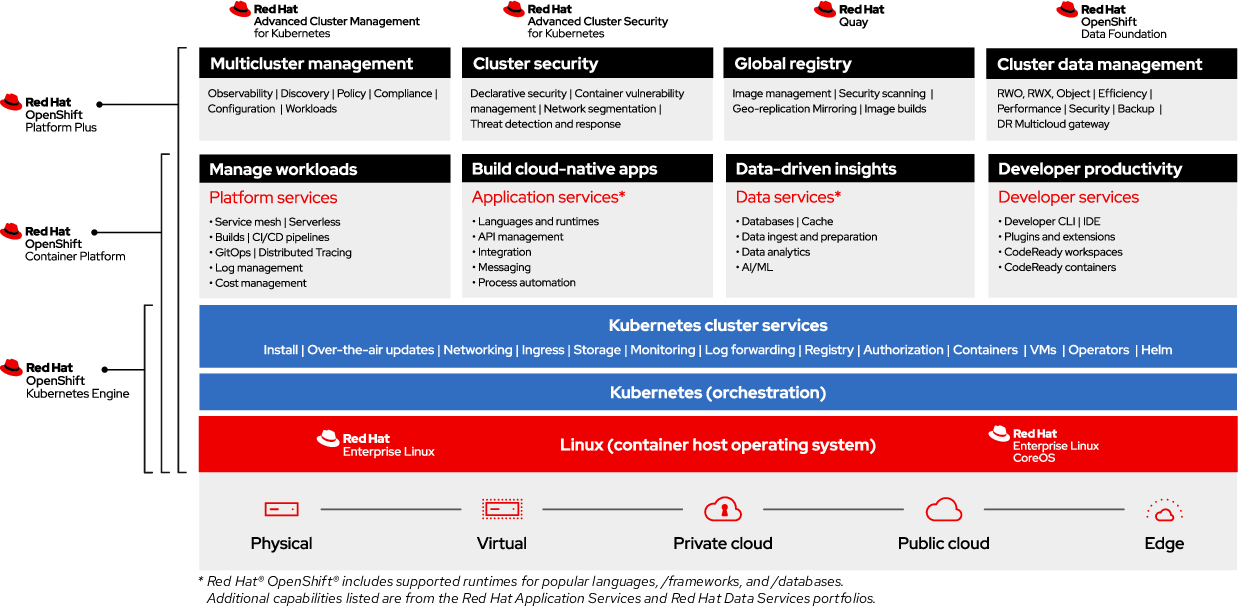Red Hat OpenShift Container Platform
Red Hat OpenShift is a platform that facilitates enterprise-level container-based application deployment and management.
Bringing together tested and reliable services, Red Hat OpenShift offers a consistent experience in general cloud, on-premises, hybrid cloud, or edge architecture to reduce the challenges in the development, modernization, deployment, operation, and management of applications.

Red Hat® OpenShift® Container Platform is the industry-leading hybrid cloud application platform supported by containers and Kubernetes. Using the OpenShift Container Platform simplifies and accelerates the development, delivery, and lifecycle management of hybrid applications consistently across on-premises, public clouds, and the edge. Whether you’re modernizing existing applications, developing new cloud-native applications, integrating data analytics, artificial intelligence, and machine learning (AI/ML) capabilities to gain data-driven insights, or integrating software from independent software vendors (ISVs) and cloud providers, OpenShift Container Platform is designed to deliver continuous innovation and speed at any scale, helping organizations be ready for today and build for the future.

OpenShift Container Platform
The OpenShift Container Platform is self-managing and includes components such as Red Hat Enterprise Linux® CoreOS, wireless updates, container runtime, network provisioning, ingress, monitoring, logging, container registry, authentication, and authorization solutions. These components are tested together for unified operations in a comprehensive Kubernetes platform that spans every cloud environment.
Red Hat OpenShift Portfolio: Diverse Container Solutions
Red Hat OpenShift is the leading enterprise Kubernetes platform trusted by organizations worldwide across industries for application innovation.
The Red Hat OpenShift Kubernetes Engine (formerly known as Red Hat OpenShift Container Engine) provides the foundational, security-focused capabilities of enterprise Kubernetes to run containers in hybrid cloud environments on Red Hat Enterprise Linux CoreOS.
The Red Hat OpenShift Container Platform adds a complete set of operational and developer services and tools, including Serverless, Service Mesh, and Pipelines. Organizations can embrace a hybrid cloud strategy and start building cloud-native applications with the OpenShift Container Platform. This proven platform includes a comprehensive service set that enables developers to code quickly and agilely for applications and provides more flexibility and efficiency for IT operations teams.
Red Hat OpenShift Platform Plus builds upon the capabilities of the OpenShift Container Platform with advanced multi-cluster security features, second-day management capabilities, integrated data management, and global container registry. With OpenShift Platform Plus, organizations can consistently protect and manage applications with enhanced security in open hybrid cloud environments and throughout the application lifecycle.

Advanced Capabilities
The OpenShift Container Platform supports multiple advanced features.
Automatic Day 1 and Day 2 Operations
Operators ensure applications run correctly and make necessary changes to adapt to the desired configuration by providing automatic installation, upgrades, and lifecycle management for applications.
Helm introduces a native package manager in Kubernetes that developers can use to package their applications and define how to package, deploy, and configure them. It can also automate Day 1 tasks and a limited number of Day 2 operations.
Red Hat OpenShift Service Mesh provides a uniform way to manage, connect, and observe applications as the management and security between services become more challenging.
Red Hat OpenShift Serverless allows an application to automatically scale up or down based on demand, using computational resources and scaling based on demand from certain event sources.
Red Hat OpenShift Pipelines brings a Kubernetes-native continuous integration and continuous development (CI/CD) solution to OpenShift with a smooth user experience through the OpenShift console, leveraging Tekton.
Red Hat OpenShift GitOps, built from the open-source Argo CD project, enables IT teams to implement GitOps workflows for cluster configuration and application deployment for faster software development with more speed, security, and scalability.
Red Hat OpenShift Virtualization brings virtual machines to Red Hat OpenShift to modernize existing applications or run them alongside containers and serverless in a Kubernetes-native architecture.
Edge Computing includes three-node clusters, remote worker nodes, and single-node clusters to provide full Kubernetes features in a smaller space.
Accelerate the deployment of intelligent applications in a hybrid cloud environment by supporting various workloads consistently among applications with a common platform.
Supported workloads include:
- Databases.
- Data analytics.
- AI/ML software, programming languages, and frameworks.
- Logging and monitoring.
- Web and application servers.
- Messaging middleware services.
Features and Benefits
Scalability: Applications running on the OpenShift Container Platform can scale to thousands of instances across hundreds of nodes within seconds.
Multi-cluster management: Unified views of clusters and the use of Kubernetes technologies provide a consistent management layer both on-site and in public clouds.
Persistent storage: The OpenShift Container Platform supports a wide range of enterprise storage solutions, including Red Hat OpenShift Data Foundation and our ecosystem (e.g., DellEMC, Portworx, NetApp), to run applications with and without state information.
Open source standards: The OpenShift Container Platform includes not only Cloud Native Computing Foundation (CNCF) certified Kubernetes but also other open-source technologies, such as container formats in the Open Containers Initiative (OCI) and container orchestration.
Container portability: Container images built on the OCI industry standard enable portability between developer workstations and production OpenShift Container Platform environments.
Automatic installation and upgrades: Automatic installation and wireless platform upgrades are supported on cloud providers like Amazon Web Services (AWS), Google Cloud Platform, IBM Cloud Virtual Private Cloud, and Microsoft Azure, as well as on-premises using VMware and vSphere, Nutanix, Red Hat OpenStack Platform, IBM Power Systems, IBM Z, LinuxONE, or bare metal. Services used from OperatorHub can be fully configured and deployed in a scalable manner with a single operation.
Pre-loaded Red Hat OpenShift hardware: Accelerate and simplify supported edge deployments with clusters that come pre-loaded with Red Hat OpenShift from our original equipment manufacturer (OEM) partners, reducing the resources and time needed to operationalize new hardware next to data sources.
Automation: Simplified and automated container and application builds, deployments, scaling, system state management, and more are standard.
Robust ecosystem: An expanding ecosystem of business partners provides a variety of integrations, including third-party storage and network providers, integrated development environments (IDEs), CI and integrations, ISV solutions, and more.
Self-service provisioning: Developers efficiently create applications on demand from their most-used tools, while operations maintain full control over the entire environment.
Multi-language support: Developers can use various languages, frameworks, and databases on the same platform.
User interfaces: Administrators and developers have direct access to rich command-line tools, an extensible web console, and Eclipse-based IDEs.
Integrated CI/CD pipelines: Developers reduce manual deployment efforts to deliver higher-quality software with CI and automated tests.
MLOps: Leverage model development, training, deployment, and monitoring capabilities not only in the cloud but also on-premises and at the edge.
User interfaces: Administrators and developers have direct access to rich command-line tools, an extensible web console, and Eclipse-based IDEs.
Source-to-image deployment: The OpenShift Container Platform provides a toolset and workflow to inject source code into a container and prepare runnable images by letting the container run this source code.
Who Uses Red Hat OpenShift?
Red Hat OpenShift provides a consistent application platform for developers and IT operators to manage hybrid cloud, multi-cloud, and edge deployments, allowing businesses to innovate rapidly.
Business Leaders
By choosing Red Hat OpenShift, business leaders assist operations teams in focusing on workload management, while developers can deploy code as they see fit. Red Hat OpenShift provides teams with a consistent user experience and a single platform for deploying and scaling digital products and services in a hybrid cloud. Regardless of where Red Hat OpenShift is deployed, teams need to learn only one interface, making changes and bringing applications to life faster and easier.
IT Operations
Red Hat OpenShift focuses on security requirements and streamlines the deployment and management of container platforms. Red Hat OpenShift provides IT operations teams with the control, visibility, and management they need to deploy, manage, and create code sequences easily with integrated platform monitoring and automatic maintenance operations and built-in upgrades.
Developers
Red Hat OpenShift provides developers with a single, consistent user experience and the freedom to quickly build and deploy applications anywhere using the tools they want. Developers can work anywhere, developing on a Kubernetes platform instead of coding the features of their existing infrastructure. This allows automation and can work anywhere, whether in-house, in a public cloud, or with a hybrid infrastructure.
Red Hat OpenShift includes a fully compliant instance of Kubernetes and is tested with dozens of technologies. It comes with Red Hat Enterprise Linux® CoreOS and supports standard Docker and CRI-O runtimes for containers managed by Red Hat Enterprise Linux for running nodes.
For more information about Red Hat OpenShift, visit the Try Red Hat OpenShift page.

